Giovanni Andrea Carlone was born in Genoa. He came from a family of artists that had included an uncle of the same name who had died in 1630. He trained in Rome from ca. 1662 and was documented in Umbria on a number of occasions in the decade from 1665. Apart from the works described below, he signed some of the frescoes (1670) in Villa Clio Carpello, outside Foligno.
Assisi
Decoration of the Cappella del SS Sacramento (1670-7)
In December 1670, the Compagnia del Sacramento and Bishop Ludovico Giustiniani commissioned Giovanni Andrea Carlone to decorate this chapel in San Rufino. This contract included:
-
✴the fresco above the apse of the chapel;
-
✴three panels for the apse; and
-
✴six panels of miracles associated with the Sacrament for the walls.
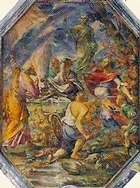
Gonfalon (1673)
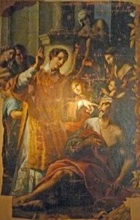
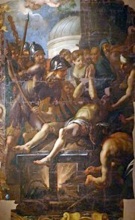
This double-sided processional banner from the Oratorio di San Lorenzo may be the work that Giovanni Andrea Carlone mentioned in a letter to Bishop Ludovico Giustiniani in 1673. It is now in the Museo Diocesano.
-
✴One side depicts St Laurence working a miracle.
-
✴The other side depicts the martyrdom of St Laurence.
Perugia
Work in the Chiesa del Gesù (1666-7)
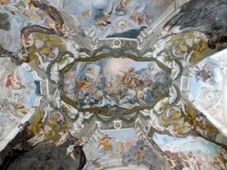
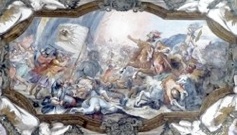
Giovanni Andrea Carlone, il Genovese executed a documented series of frescoes of scenes from the life of Joshua in the ceiling of the crossing of the Chiesa del Gesù (illustrated here).
The frescoes on the ceiling of the Oratorio degli Artisti in this church, which also have Marian iconography, are by Antonio Maria Fabrizi and Giovanni Andrea Carlone.
Frescoes in San Filippo Neri (1668-9)
Giovanni Andrea Carlone executed a number of frescoes in San Filippo Neri:
Four Evangelists
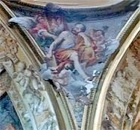
Frescoes in the Vault of the Apse
These damaged frescoes depict scenes that relate to the theology of the Immaculate Conception of the Virgin. For example, the scene directly above the curved altar wall depicts Esther pleading with the Persian King Ahasuerus for the lives of the Jews in his empire: theologians regard Esther as a prefiguration of the Immaculate Virgin.
Frescoes in the Cappella della Presentazione di Maria
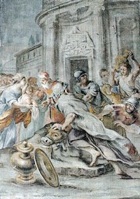
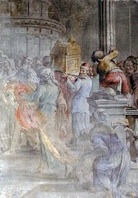
Samuel sacrifices at the Temple David entrusts the Ark of
the Covenant to Obed-Edom
These frescoes depict:
-
✴in the vaults:
-
•Noah releases a dove from the arc;
-
•Abraham leaves for Canaan; and
-
•David receives divine blessing before his war to liberate Bethlehem; and
-
✴on the walls (illustrated here):
-
•Samuel sacrifices at the Temple; and
-
•David entrusts the Ark of the Covenant to Obed-Edom.
St Bonaventure in his Study (1669)
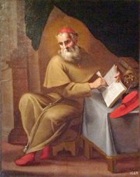
Decoration of Palazzo Ferretti (ca. 1670)
Giovanni Andrea Carlone stayed in this place as a guest of Orazio Ferretti during his stays in Perugia. He executed these frescoes for the palace (which was later known as Palazzo Conestabile della Staffa in Porta Sole and now houses the Biblioteca Augusta). Most of them have been destroyed, but one depicting the virtue of heroism survives [where?].
Work in Sant’ Ercolano (1675)
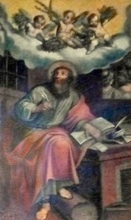
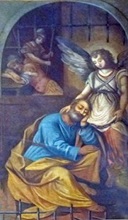
Work in Sant’ Ercolano by Giovanni Andrea Carlone includes:
-
✴two panels in the apse (illustrated above), which depict
-
•St Paul writing an epistle (on the left); and
-
•St Peter in prison (on the right); and
-
•St Paul in glory with SS Gregory the Great, Augustine and John Chrysostom (in the dome itself); and
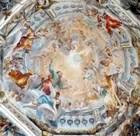
-
•scenes from the life of St Paul, in the lunettes around it, including this one of the conversion of St Paul.
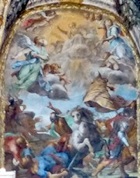
St Luke (1675)
This panel by Giovanni Andrea Carlone from the right wall of the Cappella di San Vincenzo Ferreri, San Domenico (the 2nd chapel on the left) is now apparently in the convent. The saint is depicted as an artist, and his face is a self-portrait.
Bl. Bernard Ptolomei receiving Olivetan Rule (ca. 1675)
This altarpiece by Giovanni Andrea Carlone from the Olivetan church of Sant’ Antonio Abate depicts the Blessed Bernard Ptolomei receiving the habit and rule of the Olivetans from the Bishop of Arezzo, an event that happened in 1329 at the behest of Pope John XXII. The altarpiece was originally in the sacristy. The Olivetans took the altarpiece to Montemorcino Nuovo in 1740. [When Montemorcino Nuovo passed to the University of Perugia in 1822, the altarpiece was sent to the Olivetans’ mother house, Santa Francesca Romana, Rome.]



